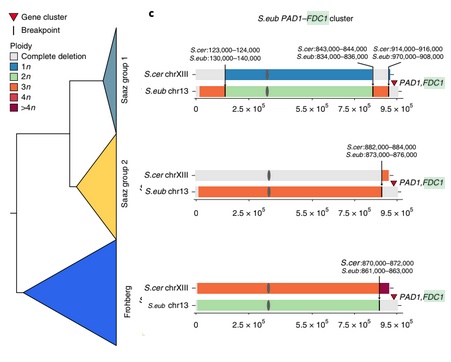Just looking at some of their spreadsheets on the Nature site - I'm intrigued which of the Sheffield breweries (presumably either Wards or Stones, the former is suspected of having "interesting" yeast) has those eubayanus x uvarum and 4-way hybrids. I'm guessing the British stout that produced NCYC 1063/4 is most likely to be Courage RIS as there weren't many other notable ones at the time they were deposited (1958) other than perhaps Mackeson, although many UK breweries produced stout alongside their main brews and to be fair the NCYC themselves describe them as ale/stout production strains.
Vin7 is an interesting Stellenbosch wine strain that
Scott Janish has been experimenting with as it is meant to be particularly good at releasing thiols. Is that a general property of kud hybrids, do Abbaye/WLP500/1214 do it too?
cerevisiae (50-60%) x eubayanus (40-50%) - Frohberg, all eubayanus mitochondria
WLP029 Kolsch, WLP051 California V, WLP515 Antwerp, WY1187 Ringwood(!!!),
SafLager-023,
WLP802 Budejovice, WLP810 San Francisco, WLP815 Belgian Lager, WLP820 Oktoberfest, WLP830 German Lager, WLP833 German Bock, WLP840 American, WLP862 Cry Havoc, WLP920 Old Bavarian, WLP940 Mexican,
WY2000 Budvar, WY2001 Urquell H-strain, WY2007 Pilsen, WY2035 American, WY2042 Danish (!), WY2112 Californian, 2xWY2124 Bohemian, 2xWY2206 Bavarian, WY2278 Czech, WY2308 Munich
DBVPG6283(yHCT111, Copenhagen beer !!), CBS1260(yHCT79 unknown beer), CBS1486(yHCT80 unknown beer), NA(yHCT145 Lager, New Glarus), NA(yHDD49 Lager, Middleton, WI), NRRL Y-48766(yHQL582 beechwood chip, Anheuser-Busch, St. Louis), CIBART79(yHCT133 Commercial beer)
Saaz : NRRL Y-12693(FM471, Copenhagen beer), CBS1538nt(yHCT83 unknown beer)
They have two 34/70 sequences that are Frohberg and one from Okuno et al that is a Saaz - presumably a mixup.
cerevisiae (45%) x eubayanus (45%) x uvarum (10%), uvarum mitochondria
WLP351, Muri
NRRL Y-48763(unknown lager 50%/1.3%/48.8%)
cerevisiae (67%-98.6%) x kudriavzevii, most kudriavzevii mitochondria
Anchor Oenology NT50 (98.6%, cerevisiae mitochondria),
ABMauri EP2 (90%, cerevisiae mitochondria), YNN48(FM64, German wine 86%), Vin7 (67%), NA (Belgian beer brewed in New Glarus WI), LallemandAbbaye , WLP500 (x2), WY1214 (last four all 77-81%)
eubayanus x uvarum
NRRL Y-672(yHQL559 - Louisville KY distillery, 45% eubayanus)
NRRL Y-12624(FM473, South Manchuria Railway Company, China), DBVPG6282(yHCT110, London ON - Labatt????), NRRL Y-587(yHQL556, Schlitz beer), NRRL Y-648(yHQL558, unknown lager), NRRL Y-1566(yHQL566, Japan brewery)
NRRL Y-1901(yHQL567), NRRL Y-1906(yHQL569), NRRL Y-1910(yHQL581 all 3 from Sheffield UK beer)
cerevisiae x kudriavzevii x eubayanus x uvarum
NRRL Y-1531(yHQL563, UK ale), NRRL Y-1905(yHQL568 Sheffield UK beer)
cerevisiae
Muntons,
BelleSaison, LondonESB, Munich, Nottingham, Nottingham, Windsor,
S-33, SafaleK-97, SafaleS-04, SafaleS-05, T-58, US-05, WB-06,
WLP001, WLP002, WLP004, WLP007, WLP013, WLP023, WLP028, WLP090, WLP099, WLP300, WLP320, WLP380, WLP400, WLP510, WLP530B, WLP545, WLP550, WLP565, WLP566, WLP570, WLP644, WLP715, WLP775, WLP800, WLP838,
WY1007, WY1026, WY1028, WY1028, WY1098, WY1272, WY1318, WY1388, WY1728, WY1792, WY1968, WY2565, WY3068, WY3463, WY3522, WY3724, WY3787, WY3787, WY4766
CoteDesBlancs, EC1118, PasteurRed, YNN49(FM65, Bordeaux wine)
Turbo Super Yeast, Liquor Quik Whisky Pure - both distilling
AnchorBrewersYeast, NPC-HighfoamSuperbrew(both South African bakers yeasts)
NCYC1063(yHQL579 British stout), NCYC1064(yHQL577 British stout), NA(yHQL578 Irish stout),
NA(yHAB176 Pale Ale, Amana IA) - Millstream?
NA(yHAB174 Belgian Tripel Everett WA) - Scuttlebutt Tripel 7?
blueberryAle(yHKS338) - Tahquamenon Falls Brewery & Pub Blueberry Ale?
Belgian(yHCT146), Green(yHCT143), Weiss(yHCT147), White(yHCT144) - all New Glarus













![Craft A Brew - Safale S-04 Dry Yeast - Fermentis - English Ale Dry Yeast - For English and American Ales and Hard Apple Ciders - Ingredients for Home Brewing - Beer Making Supplies - [1 Pack]](https://m.media-amazon.com/images/I/41fVGNh6JfL._SL500_.jpg)













































